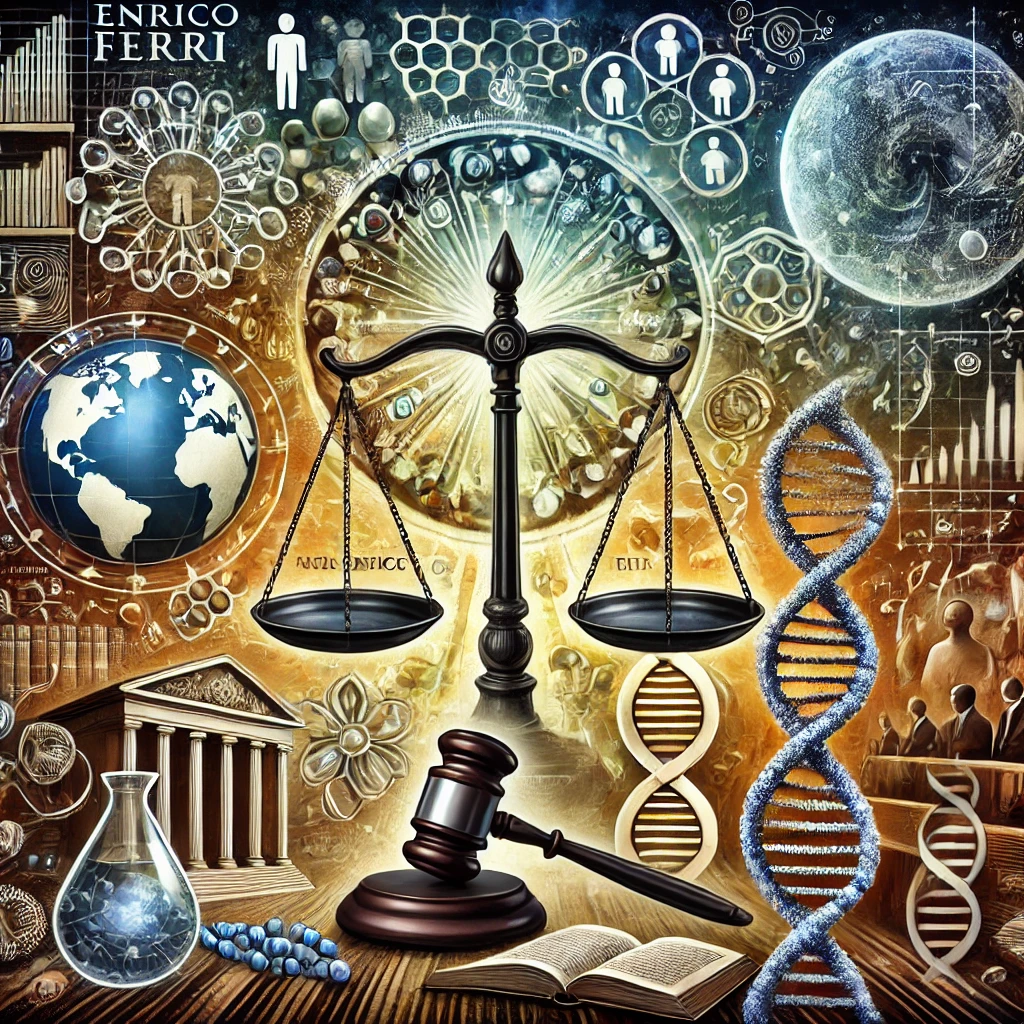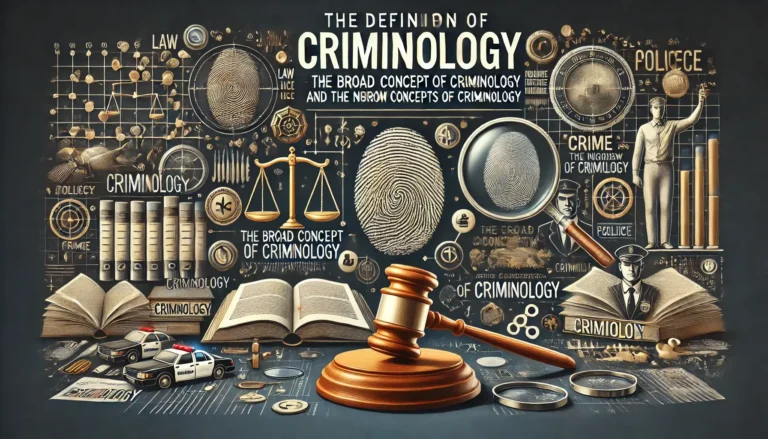Enrico Ferri’s Theory of Multiple Causes in Criminology
Enrico Ferri (1856–1929) was an Italian criminologist and one of the leading figures in the development of modern criminological theory. Ferri’s theory of multiple causes represents a significant shift in the way criminology views criminal behavior. Unlike previous theories that focused on single factors, such as biological or psychological influences, Ferri proposed that crime is the result of a complex interplay of multiple causes, including social, economic, environmental, and biological factors. His theory is often seen as an extension and refinement of Cesare Lombroso’s biological determinism, but with a more comprehensive and integrated approach.
This article aims to explore Ferri’s theory of multiple causes, examining its foundations, key components, and its impact on the field of criminology.
The Historical Context of Ferri’s Theory
To understand Ferri’s contribution to criminology, it is essential to consider the historical context in which he developed his ideas. During the late 19th century, criminology was undergoing significant transformation. The positivist school of criminology, which sought to apply scientific methods to the study of crime, was gaining prominence. This approach stood in contrast to earlier, more philosophical views on crime and punishment, such as those espoused by Cesare Beccaria, which focused more on the moral and legal aspects of criminal behavior.
Ferri was heavily influenced by Lombroso’s biological theories, but he was also critical of Lombroso’s focus on physical determinism. Lombroso’s theory emphasized the idea that criminality was innate and could be identified through physical characteristics, such as the shape of the skull or the presence of certain “atavistic” features. While Lombroso’s approach laid the foundation for modern criminology, Ferri believed that it oversimplified the complexities of criminal behavior and ignored the role of social and environmental factors.
The Core Principles of Ferri’s Theory of Multiple Causes
Ferri’s theory of multiple causes posits that criminal behavior cannot be explained by a single factor, whether biological, psychological, or social. Instead, crime is the product of the interaction between various factors. Ferri identified three primary categories of causes that contribute to criminal behavior: physical (biological), anthropological (psychological and personal), and social (environmental and cultural). These causes work together to create the conditions under which criminal behavior emerges.
- Physical Causes (Biological Factors)
Ferri acknowledged the role of biological and physiological factors in influencing criminal behavior, but he did not consider them to be deterministic. He agreed with Lombroso that certain genetic and physical traits may predispose individuals to criminal tendencies, such as an impulsive personality or an underdeveloped sense of empathy. However, Ferri argued that these biological factors alone were insufficient to explain crime. Instead, they must be understood in conjunction with other social and environmental factors. - Anthropological Causes (Psychological and Personal Factors)
Ferri placed significant emphasis on the psychological and personal characteristics of individuals as contributing factors to criminal behavior. He recognized that psychological conditions, such as mental illness, emotional instability, or antisocial personality traits, could make individuals more susceptible to engaging in criminal activities. This category of causes also includes personal experiences, such as early childhood trauma, abuse, or neglect, which may lead to the development of criminal tendencies. - Social Causes (Environmental and Societal Factors)
The most important aspect of Ferri’s theory is his focus on social causes. Ferri argued that crime is a social phenomenon that is deeply influenced by the environment in which individuals live. Factors such as poverty, unemployment, lack of education, and social disintegration play a critical role in fostering criminal behavior. Ferri believed that individuals living in disadvantaged social conditions were more likely to resort to crime as a means of survival or to express their frustration with the system. He also pointed to the influence of peer groups and the breakdown of traditional family structures as significant contributors to criminal behavior.
Ferri’s Impact on Criminology
Ferri’s theory of multiple causes was groundbreaking for its time because it provided a more comprehensive and nuanced explanation of crime. By considering the complex interactions between biological, psychological, and social factors, Ferri’s approach moved away from deterministic models of criminality that were prevalent in the 19th century.
- Shift from Biological Determinism
Ferri’s theory helped move criminology away from a narrow focus on biological determinism, as seen in Lombroso’s work. While biological factors are still considered important in understanding criminal behavior, Ferri emphasized that they cannot be viewed in isolation. His theory underscored the importance of a more holistic understanding of crime, one that accounts for both individual predispositions and external influences. - The Role of Social Environment
Ferri’s emphasis on the social causes of crime was revolutionary. He argued that criminal behavior is often a response to the conditions in which individuals live, and that societal structures—such as poverty, inequality, and poor living conditions—play a significant role in the development of criminal behavior. This perspective paved the way for later sociological theories of crime, such as strain theory and social disorganization theory, which also focus on the relationship between social conditions and crime. - Criminal Prevention and Social Reform
One of Ferri’s most important contributions was his belief in the potential for social reform to prevent crime. He argued that by addressing the root social causes of crime—such as poverty, unemployment, and social inequality—societies could reduce crime rates. Ferri advocated for comprehensive social policies that would provide better education, healthcare, and economic opportunities to disadvantaged groups. He believed that crime prevention could only be achieved through broad social reforms aimed at improving the living conditions of the most vulnerable members of society.
Criticism and Legacy of Ferri’s Theory
Despite the lasting impact of Ferri’s work, his theory of multiple causes has been subject to criticism over the years. Critics argue that while Ferri’s holistic approach was innovative, it remains difficult to quantify the influence of each factor in isolation. The interplay between biological, psychological, and social factors is complex, and determining the exact weight of each cause in a particular instance of criminal behavior can be challenging.
Moreover, some scholars contend that Ferri’s theory, while emphasizing the importance of social factors, does not fully account for the role of free will and individual agency in criminal behavior. By attributing crime to a variety of factors beyond the individual’s control, Ferri’s theory has been accused of diminishing personal responsibility.
However, despite these criticisms, Ferri’s contributions remain central to the field of criminology. His emphasis on the complex and interconnected nature of criminal behavior laid the groundwork for future research in criminology, particularly in the areas of biopsychosocial models of crime. His theory has also influenced modern criminological approaches that advocate for the integration of multiple disciplines, including sociology, psychology, biology, and law, to better understand and address criminal behavior.
Conclusion: The Relevance of Ferri’s Theory Today
Enrico Ferri’s theory of multiple causes has had a profound and lasting impact on criminology. His approach challenges simplistic, single-factor explanations of crime and encourages a more nuanced understanding of criminal behavior. By recognizing the interplay of biological, psychological, and social factors, Ferri’s theory continues to inform modern criminological research and policy development. It reminds us that crime cannot be understood through one lens alone and that addressing its root causes requires a multifaceted approach that considers both individual and societal factors. Ferri’s theory remains an essential component of criminology, particularly in efforts to develop more effective crime prevention and rehabilitation strategies.







